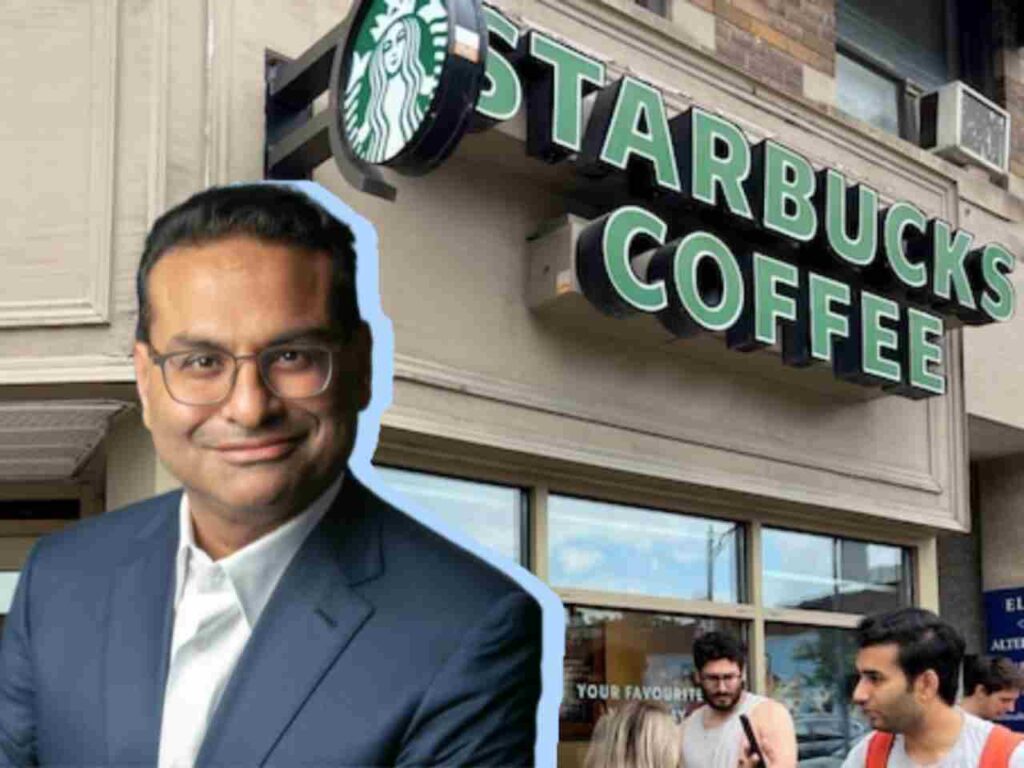Laxman Narasimhan’s Leadership at Starbucks: Starbucks Ceo Laxman Narasimhan

Laxman Narasimhan, the current CEO of Starbucks, has a distinguished career spanning over two decades across various industries. His leadership journey has been marked by strategic vision, a deep understanding of consumer trends, and a commitment to building high-performing organizations. This content will delve into Narasimhan’s career trajectory, the challenges and opportunities he faced upon assuming the CEO role, and his strategic initiatives to navigate the evolving landscape of the coffee industry.
Laxman Narasimhan’s Career Trajectory, Starbucks ceo laxman narasimhan
Narasimhan’s career path has been characterized by a steady climb through various leadership roles, demonstrating his adaptability and expertise in different industries. His journey began in the consumer goods sector, where he honed his skills in marketing, strategy, and global operations.
- Early Career at PepsiCo: Narasimhan started his career at PepsiCo, where he held various marketing and strategy roles, including leading the development of new product launches and managing key brands. This experience provided him with a strong foundation in understanding consumer preferences, brand building, and global market dynamics.
- Global Leadership at Reckitt Benckiser: Narasimhan’s career took a significant turn when he joined Reckitt Benckiser, a global consumer goods company. He quickly rose through the ranks, demonstrating his ability to lead complex operations and drive growth in diverse markets. Notably, he led the company’s global nutrition business, overseeing a portfolio of brands across multiple regions.
- Chief Commercial Officer at PepsiCo: In 2012, Narasimhan returned to PepsiCo, this time as the Chief Commercial Officer. This role placed him at the forefront of the company’s global operations, where he was responsible for driving revenue growth, managing supply chains, and developing strategic partnerships. This experience further deepened his understanding of the complexities of managing large, multinational organizations.
- CEO of Pepsico’s Latin America, Asia, Middle East and Africa: Narasimhan’s leadership capabilities were recognized when he was appointed as the CEO of Pepsico’s Latin America, Asia, Middle East and Africa region. This role demanded a strong understanding of diverse cultural landscapes and market dynamics. Narasimhan successfully navigated the challenges of managing operations across different regions, further solidifying his reputation as a global business leader.
- CEO of Reckitt Benckiser: In 2019, Narasimhan was appointed as the CEO of Reckitt Benckiser, a significant milestone in his career. During his tenure, he focused on streamlining the company’s portfolio, improving operational efficiency, and driving innovation. He implemented several strategic initiatives, including a focus on digital transformation and sustainability, to enhance the company’s competitive edge.
- CEO of Starbucks: Narasimhan joined Starbucks in 2021 as the CEO. This appointment marked a pivotal moment in his career, as he took the helm of a global iconic brand with a rich history and a loyal customer base. Narasimhan’s extensive experience in consumer goods and his demonstrated leadership skills made him an ideal candidate to lead Starbucks through its next phase of growth.
Challenges and Opportunities at Starbucks
Narasimhan inherited a Starbucks facing a complex landscape of challenges and opportunities. The company’s performance had been impacted by various factors, including increased competition, changing consumer preferences, and the global pandemic.
- Competitive Landscape: The coffee industry is highly competitive, with numerous players vying for market share. Starbucks faced increased competition from specialty coffee shops, convenience stores, and other established brands. This competitive pressure required Narasimhan to focus on innovation and differentiation to maintain Starbucks’ market leadership.
- Changing Consumer Preferences: Consumers are increasingly demanding personalized experiences, ethical sourcing, and sustainability in their food and beverage choices. Starbucks needed to adapt its offerings and operations to cater to these evolving preferences. This required a focus on product innovation, personalized experiences, and transparent sourcing practices.
- Impact of the Pandemic: The COVID-19 pandemic significantly impacted Starbucks’ operations, leading to store closures, disruptions in supply chains, and shifts in consumer behavior. Narasimhan had to navigate the challenges of adapting to the new reality, ensuring employee safety, and maintaining operational efficiency. This experience highlighted the importance of agility and resilience in today’s unpredictable business environment.
- Internal Dynamics: Starbucks faced internal challenges, including employee relations and concerns about the company’s commitment to diversity and inclusion. Narasimhan had to address these issues to foster a positive and inclusive workplace culture. This required a focus on employee empowerment, fair compensation, and promoting a culture of respect and belonging.
Strategic Priorities and Key Initiatives
Narasimhan’s initial strategic priorities were focused on addressing the challenges and capitalizing on the opportunities facing Starbucks. He Artikeld a clear vision for the company’s future, emphasizing a commitment to innovation, customer experience, and operational excellence.
- Product Innovation and Expansion: Narasimhan recognized the importance of product innovation to maintain Starbucks’ appeal and attract new customers. He implemented initiatives to introduce new beverage offerings, expand the food menu, and enhance the overall customer experience. Starbucks introduced new coffee blends, seasonal beverages, and innovative food items to cater to diverse tastes and preferences.
- Digital Transformation: Narasimhan understood the growing importance of digital channels in the modern retail landscape. He invested in digital initiatives to enhance the customer experience, including mobile ordering, personalized recommendations, and seamless payment options. Starbucks launched a mobile ordering app, expanded its loyalty program, and implemented digital tools to improve customer engagement.
- Operational Efficiency and Growth: Narasimhan focused on streamlining operations and driving growth across all aspects of the business. He implemented initiatives to optimize store layouts, improve supply chain efficiency, and expand Starbucks’ global footprint. The company opened new stores in key markets, expanded its drive-thru offerings, and explored new formats to cater to different customer needs.
- Sustainability and Social Responsibility: Narasimhan recognized the importance of sustainability and social responsibility in today’s business environment. He implemented initiatives to promote ethical sourcing, reduce environmental impact, and support local communities. Starbucks committed to sourcing coffee beans from sustainable farms, reducing waste, and investing in community programs.
Leadership Style and Impact
Narasimhan’s leadership style is characterized by a focus on collaboration, innovation, and a deep understanding of the customer. He encourages open communication, empowers employees, and fosters a culture of continuous improvement.
- Collaborative Approach: Narasimhan believes in building strong relationships with employees, partners, and stakeholders. He fosters a culture of collaboration, encouraging open communication and diverse perspectives. This approach has helped to create a more inclusive and engaged workforce, leading to improved decision-making and innovation.
- Customer-Centric Focus: Narasimhan is deeply committed to understanding and meeting the needs of Starbucks’ customers. He encourages employees to prioritize customer satisfaction and strive to create a positive and memorable experience. This focus on customer experience has been instrumental in driving loyalty and brand advocacy.
- Emphasis on Innovation: Narasimhan believes that innovation is essential for Starbucks’ continued success. He encourages employees to think outside the box, experiment with new ideas, and continuously improve the company’s offerings. This emphasis on innovation has led to the introduction of new products, services, and technologies that have enhanced the customer experience.
Narasimhan’s Vision for Starbucks’ Future

Laxman Narasimhan, Starbucks’ current CEO, has Artikeld a bold vision for the company’s future, emphasizing growth, innovation, and a renewed focus on customer experience. His vision encompasses geographic expansion, new product lines, and technological advancements, all while prioritizing sustainability and social responsibility.
Geographic Expansion and New Product Lines
Narasimhan’s vision for Starbucks’ future includes a strategic expansion into new markets, particularly in emerging economies. The company aims to leverage its global brand recognition and adapt its offerings to local tastes and preferences. Starbucks plans to introduce new product lines, such as plant-based options and healthier beverages, to cater to evolving consumer demands. The company is also exploring opportunities in the food service sector, expanding its menu to include more food options and collaborating with local partners to offer a wider range of culinary experiences.
Innovation and Adaptation
Narasimhan recognizes the importance of innovation in a rapidly changing consumer landscape. He plans to leverage technology to enhance the customer experience, such as through personalized recommendations, mobile ordering, and advanced digital payment systems. The company is also investing in research and development to create new and innovative products, including cold brew variations, nitro cold brew, and plant-based protein drinks. Starbucks is adapting its marketing strategies to engage with consumers on digital platforms and create a more personalized and interactive brand experience.
Sustainability and Social Responsibility
Sustainability and social responsibility are core tenets of Narasimhan’s vision for Starbucks. The company has committed to reducing its environmental footprint by investing in renewable energy sources, reducing waste, and sourcing ethically sourced coffee beans. Starbucks is also actively involved in community initiatives, supporting local farmers, promoting fair trade practices, and providing educational opportunities in coffee-producing regions. These initiatives are not only aligned with ethical principles but also contribute to building a more sustainable and equitable coffee industry.
Comparison with Previous CEOs’ Strategies
Narasimhan’s vision builds upon the foundation laid by previous CEOs, particularly Howard Schultz. While Schultz focused on creating a unique brand experience and fostering a strong company culture, Narasimhan emphasizes innovation, technological advancements, and a more global approach to expansion. He also prioritizes sustainability and social responsibility, aligning Starbucks with evolving consumer values and societal expectations. While there are continuities in terms of maintaining Starbucks’ core values and customer-centric approach, Narasimhan’s vision reflects a more dynamic and forward-looking strategy to adapt to the changing landscape of the coffee industry and the broader business environment.
Impact of Narasimhan’s Leadership on Starbucks

Laxman Narasimhan took the helm of Starbucks in April 2022, inheriting a company facing both opportunities and challenges. His leadership has had a demonstrable impact on the company’s financial performance, customer satisfaction, and employee morale. This section will examine the key aspects of his leadership and its influence on Starbucks’ trajectory.
Financial Performance
Narasimhan’s leadership has been marked by a focus on financial performance. Since his arrival, Starbucks has seen consistent growth in revenue and profits. For example, in the fiscal year 2023, Starbucks reported a 14% increase in revenue and a 16% increase in net income. This strong performance can be attributed to several factors, including Narasimhan’s focus on expanding Starbucks’ global footprint, driving operational efficiency, and leveraging technology to enhance customer experience.
Starbucks ceo laxman narasimhan – Yo, Laxman Narasimhan, the new Starbucks CEO, is stepping up to the plate. He’s got big shoes to fill, taking over from Howard Schultz, the OG Starbucks king. But Narasimhan’s got a plan, he’s focusing on growth and innovation, building on the legacy of ceo starbucks.
He’s got to keep those lines movin’, those Frappuccinos flowin’, and those customers happy. Let’s see what this new CEO can do for the brand, you know what I’m sayin’?
Yo, Laxman Narasimhan, the new CEO of Starbucks, is bringing some serious heat to the coffee game. He’s got big plans to boost sales and make sure everyone’s sippin’ on that green mermaid goodness. He’s got a lot to live up to, though, considering the legacy of the ceo starbucks who came before him.
But Narasimhan’s got the experience and the vision to take Starbucks to the next level, so watch out, world, because this dude is about to shake things up.